Mindshift: Break Through Obstacles to Learning and Discover Your Hidden PotentialBarbara Oakley Mindshift reveals how we can overcome stereotypes and preconceived ideas about what is possible for us to learn and become.
At a time when we are constantly being asked to retrain and reinvent ourselves to adapt to new technologies and changing industries, this book shows us how we can uncover and develop talents we didn’t realize we had—no matter what our age or background. We’re often told to “follow our passions.” But in Mindshift, Dr. Barbara Oakley shows us how we can broaden our passions. Drawing on the latest neuroscientific insights, Dr. Oakley shepherds us past simplistic ideas of “aptitude” and “ability,” which provide only a snapshot of who we are now—with little consideration about how we can change.
Even seemingly “bad” traits, such as a poor memory, come with hidden advantages—like increased creativity. Profiling people from around the world who have overcome learning limitations of all kinds, Dr. Oakley shows us how we can turn perceived weaknesses, such as impostor syndrome and advancing age, into strengths. People may feel like they’re at a disadvantage if they pursue a new field later in life; yet those who change careers can be fertile cross-pollinators: They bring valuable insights from one discipline to another. Dr. Oakley teaches us strategies for learning that are backed by neuroscience so that we can realize the joy and benefits of a learning lifestyle. Mindshift takes us deep inside the world of how people change and grow. Our biggest stumbling blocks can be our own preconceptions, but with the right mental insights, we can tap into hidden potential and create new opportunities. Objective-C Programmer's ReferenceCarlos Oliveira Objective-C Programmer's Reference is a book for professional developers in Objective-C, or who are moving to Objective-C from other languages. The book is a concisely written combination of expert-level tutorial and long-term reference. It reaches readers who lack the time to invest in more traditional books, which usually spend hundreds of pages to explain simple concepts already a part of the working programmer’s standard vocabulary.
Objective-C Programmer's Reference provides the tools necessary to build working solutions in Objective-C—the language of choice for developing iOS and OS X applications for iPhones, iPads, and Mac notebooks and desktops. Author Carlos Oliveira begins from the basic building blocks of the language. He shows how to create correct and efficient applications by applying your knowledge of object-oriented programming, as well as of structured programming. This book: Takes you quickly through fundamental concepts such as interfaces and class implementations in Objective-C.Provides a concise and handy reference to the Foundation Framework that is all-important when programming in Objective-C.Highlights key differences between Objective-C and other popular languages such as Java or Python.Shows how to create full applications using advanced concepts such as container classes, selectors, and key-value interfaces.Provides the fundamentals of writing Cocoa and Cocoa Touch applications, which are the standard for Mac OS X and iOS development.
Objective-C Programmer's Reference is not a large book filled with introductory topics already well-understood by professional developers. Discussion of broadly-understood concepts such as branching and looping is blissfully short and fast-paced. The book assumes and makes extensive use of those and other concepts already mastered by developers who are fluent in other languages such as C++, Java, Perl, and Python. Reference material is included for quick answers to common questions on the Foundation Framework, on compiling, on the pre-processor, and more. The author’s approach is logical and structured, and even novice programmers will have an easy time absorbing the most important topics and competencies necessary to develop applications in Objective-C. What you’ll learn Grasp the basic syntax of the Objective-C language.Create classes and methods in Objective-C.Apply Objective-C’s message-passing mechanism to simplify your code and avoid deep class hierarchies.Store and access dynamic data through Objective-C’s built-in, key-value system.Make effective use of container classes such as arrays and dictionaries with their immutable and mutable versions.Create simple applications for iPhones, iPads, Macbooks, and other iOS and Mac OS X devices.Who this book is for
Objective-C Programmer's Reference is for programmers in Objective-C who are looking for a handy reference to keep them on top of their game. The book is also designed for programmers moving to Objective-C from some other language, especially from another C-like language such as Java or C#, providing just that additional bit that is needed to transfer their expertise into Objective-C and get a leg up on creating applications for the iOS and Mac OS X platforms underlying Apple’s hugely successful devices such as the iPhone, iPad, and Macbook. Git Version Control CookbookAske Olsson, Rasmus Voss 90 hands-on recipes that will increase your productivity when using Git as a version control system
OverviewFilled with practical recipes that will teach you how to use the most advanced features of the Git systemImprove your productivity by learning to work faster, more efficiently, and with more confidenceDiscover tips and tricks that will show you when and how to use the advanced features of Git
In Detail
Starting with the Git data model, you will learn how Git stores files and how it looks at commits. You will then learn how you can recover from mistakes; from committing on the wrong branch to recovering lost commits/files. Next, you will discover how you can force rebase on some branches and use regular Git merge on other branches. You will also learn how to extract information from the repository.
As you progress through this book, you will learn how you can automate the usual Git processes by utilizing the hook system built into Git. The book also covers advanced repository management, including different options to rewrite the history of a Git repository. Finally, you will discover how you can work offline with Git, how to track what is going on behind the scenes, and how to use the stash for different purposes.
What you will learn from this bookUnderstand the Git data model and how you can navigate the database with simple commandsLearn how you can recover lost commits/filesDiscover how you can force rebase on some branches and use regular Git merge on other branchesExtract metadata from a Git repositoryFamiliarize yourself with Git notesDiscover how you can work offline with GitDebug with Git and use various techniques to find the faulty commit
Approach
This practical guide contains a wide variety of recipes, taking you through all the topics you need to know about to fully utilize the most advanced features of the Git system.
Who this book is written for
If you are a software developer or a build and release engineer who uses Git in your daily work and want to take your Git knowledge to the next level, then this book is for you. To understand and follow the recipes included in this book, basic knowledge of Git command-line code is mandatory. The Ultimate CSS ReferenceTommy Olsson, Paul O'Brien A complete and thorough and up-to-date reference guide for CSS.
Stop wasting time doing Internet searches only to find inaccurate, out-of-date, or incomplete information. CSS: The Ultimate Reference includes all the ins-and-outs you need to know including compatability information for all major browsers, lists of useful hacks, known bugs in CSS, and much more - all presented in a beautiful, full color layout that will have you coming back over and over again.
Coverage includes:
CSS 2.1 syntax and specifications, including features from current CSS 3 working drafts that are implemented in one or more major browsers (IE, Firefox, Safari, Opera), and useful browser-specific featuresA clear and concise guide to the CSS cascade, including compatability information, known bugs and useful CSS hacksA media type guide, with coverage of which media types apply in which user agents under what conditions.A quick-reference guide to currently supported at-rules (@import, @media, etc.).An alphabetical property reference Managing Projects with makeAndrew Oram, Steve Talbott make is one of UNIX's greatest contributions to software development, and this book is the clearest description of make ever written. Even the smallest software project typically involves a number of files that depend upon each other in various ways. If you modify one or more source files, you must relink the program after recompiling some, but not necessarily all, of the sources. make greatly simplifies this process. By recording the relationships between sets of files, make can automatically perform all the necessary updating. For large projects with teams of programmers and multiple releases, make becomes even more critical. But in order to avoid spending a major portion of your maintenance budget on maintaining the Makefiles, you need a system for handling directories, dependencies, and macro definitions. This book describes all the basic features of make and provides guidelines on meeting the needs of large, modern projects. Some of the issues addressed in the second edition include:Projects covering several directories.Maintaining consistency when building variants of a program.Automatic generation of header file dependencies.Forced rebuilds of existing files.A description of free products that contain major enhancements to make.Listings of the features that vary between different versions of make and simple ways to test them.More detail and examples on common errors, use of the shell in make, formal rules of syntax in make, and support for various utilities. Network Analysis Using Wireshark CookbookYoram Orzach This book will be a massive ally in troubleshooting your network using Wireshark, the world's most popular analyzer. Over 100 practical recipes provide a focus on real-life situations, helping you resolve your own individual issues.
OverviewPlace Wireshark in your network and configure it for effective network analysisConfigure capture and display filters to get the required dataUse Wireshark’s powerful statistical tools to analyze your network and its expert system to pinpoint network problems
In Detail
Is your network slow? Are your users complaining? Disconnections? IP Telephony problems? Video freezes? Network analysis is the process of isolating these problems and fixing them, and Wireshark has long been the most popular network analyzer for achieving this goal. Based on hundreds of solved cases, Network Analysis using Wireshark Cookbook provides you with practical recipes for effective Wireshark network analysis to analyze and troubleshoot your network.
"Network analysis using Wireshark Cookbook" highlights the operations of Wireshark as a network analyzer tool. This book provides you with a set of practical recipes to help you solve any problems in your network using a step-by-step approach.
"Network analysis using Wireshark Cookbook" starts by discussing the capabilities of Wireshark, such as the statistical tools and the expert system, capture and display filters, and how to use them. The book then guides you through the details of the main networking protocols, that is, Ethernet, LAN switching, and TCP/IP, and then discusses the details of application protocols and their behavior over the network. Among the application protocols that are discussed in the book are standard Internet protocols like HTTP, mail protocols, FTP, and DNS, along with the behavior of databases, terminal server clients, Citrix, and other applications that are common in the IT environment.
In a bottom-up troubleshooting approach, the book goes up through the layers of the OSI reference model explaining how to resolve networking problems. The book starts from Ethernet and LAN switching, through IP, and then on to TCP/UDP with a focus on TCP performance problems. It also focuses on WLAN security. Then, we go through application behavior issues including HTTP, mail, DNS, and other common protocols. The book finishes with a look at network forensics and how to search and find security problems that might harm the network.
What you will learn from this bookConfigure Wireshark for effective network troubleshootingSet up various display and capture filtersUse basic statistical tools that provide you with "who is talking" tables, conversations, and HTTP statisticsMaster both the standard and advanced features of IO graphsUse the expert system to pinpoint various types of events that might influence the behavior of your networkLearn about Wi-Fi testing and how to resolve problems related to wireless LANsExplore performance issues in TCP/IPExplore failures due to delays and jitters in the networkFind and resolve problems due to bandwidth, throughput, and packet lossIdentify and locate faults in communication applications including HTTP, FTP, mail, and various other applications – Microsoft OS problems, databases, voice, and video over IPIdentify and locate faults in detecting security failures and security breaches in the network | DSP for Embedded and Real-Time SystemsRobert Oshana This Expert Guide gives you the techniques and technologies in digital signal processing (DSP) to optimally design and implement your embedded system. Written by experts with a solutions focus, this encyclopedic reference gives you an indispensable aid to tackling the day-to-day problems you face in using DSP to develop embedded systems.
With this book you will learn:
A range of development techniques for developing DSP code
Valuable tips and tricks for optimizing DSP software for maximum performance
The various options available for constructing DSP systems from numerous software components
The tools available for developing DSP applications
Numerous practical guidelines from experts with wide and lengthy experience of DSP application development
Features:
Several areas of research being done in advanced DSP technology
Industry case studies on DSP systems development
DSP software development tools available for download and evaluation
DSP for Embedded and Real-Time Systems is the reference for both the beginner and experienced, covering most aspects of using today's DSP techniques and technologies for designing and implementing an optimal embedded system. The only complete reference which explains all aspects of using DSP in embedded systems development making it a rich resource for every day useCovers all aspects of using today's DSP techniques and technologies for designing and implementing an optimal embedded systemEnables the engineer to find solutions to all the problems they will face when using DSP Software Engineering for Embedded Systems: Methods, Practical Techniques, and ApplicationsRobert Oshana, Mark Kraeling This Expert Guide gives you the techniques and technologies in software engineering to optimally design and implement your embedded system. Written by experts with a solutions focus, this encyclopedic reference gives you an indispensable aid to tackling the day-to-day problems when using software engineering methods to develop your embedded systems.
With this book you will learn:
The principles of good architecture for an embedded system
Design practices to help make your embedded project successful
Details on principles that are often a part of embedded systems, including digital signal processing, safety-critical principles, and development processes
Techniques for setting up a performance engineering strategy for your embedded system software
How to develop user interfaces for embedded systems
Strategies for testing and deploying your embedded system, and ensuring quality development processes
Practical techniques for optimizing embedded software for performance, memory, and power
Advanced guidelines for developing multicore software for embedded systems
How to develop embedded software for networking, storage, and automotive segments
How to manage the embedded development process
Includes contributions from:
Frank Schirrmeister, Shelly Gretlein, Bruce Douglass, Erich Styger, Gary Stringham, Jean Labrosse, Jim Trudeau, Mike Brogioli, Mark Pitchford, Catalin Dan Udma, Markus Levy, Pete Wilson, Whit Waldo, Inga Harris, Xinxin Yang, Srinivasa Addepalli, Andrew McKay, Mark Kraeling and Robert Oshana. Road map of key problems/issues and references to their solution in the text
Review of core methods in the context of how to apply them
Examples demonstrating timeless implementation details
Short and to- the- point case studies show how key ideas can be implemented, the rationale for choices made, and design guidelines and trade-offs Mathematics of Discrete Structures for Computer ScienceGordon J. Pace Mathematics plays a key role in computer science, some researchers would consider computers as nothing but the physical embodiment of mathematical systems. And whether you are designing a digital circuit, a computer program or a new programming language, you need mathematics to be able to reason about the design — its correctness, robustness and dependability. This book covers the foundational mathematics necessary for courses in computer science.
The common approach to presenting mathematical concepts and operators is to define them in terms of properties they satisfy, and then based on these definitions develop ways of computing the result of applying the operators and prove them correct. This book is mainly written for computer science students, so here the author takes a different approach: he starts by defining ways of calculating the results of applying the operators and then proves that they satisfy various properties. After justifying his underlying approach the author offers detailed chapters covering propositional logic, predicate calculus, sets, relations, discrete structures, structured types, numbers, and reasoning about programs. The book contains chapter and section summaries, detailed proofs and many end-of-section exercises — key to the learning process. The book is suitable for undergraduate and graduate students, and although the treatment focuses on areas with frequent applications in computer science, the book is also suitable for students of mathematics and engineering. Beginning R: An Introduction to Statistical ProgrammingLarry Pace Beginning R: An Introduction to Statistical Programming is a hands-on book showing how to use the R language, write and save R scripts, build and import data files, and write your own custom statistical functions. R is a powerful open-source implementation of the statistical language S, which was developed by AT&T. R has eclipsed S and the commercially-available S-Plus language, and has become the de facto standard for doing, teaching, and learning computational statistics.
R is both an object-oriented language and a functional language that is easy to learn, easy to use, and completely free. A large community of dedicated R users and programmers provides an excellent source of R code, functions, and data sets. R is also becoming adopted into commercial tools such as Oracle Database. Your investment in learning R is sure to pay off in the long term as R continues to grow into the go to language for statistical exploration and research.
Covers the freely-available R language for statisticsShows the use of R in specific uses case such as simulations, discrete probability solutions, one-way ANOVA analysis, and moreTakes a hands-on and example-based approach incorporating best practices with clear explanations of the statistics being done
What you’ll learn Acquire and install RImport and export data and scriptsGenerate basic statistics and graphicsProgram in R to write custom functionsUse R for interactive statistical explorationsImplement simulations and other advanced techniquesWho this book is for
Beginning R: An Introduction to Statistical Programming is an easy-to-read book that serves as an instruction manual and reference for working professionals, professors, and students who want to learn and use R for basic statistics. It is the perfect book for anyone needing a free, capable, and powerful tool for exploring statistics and automating their use. Table of Contents Part I. Learning the R Language
1. Getting R and Getting Started
2. Programming in R
3. Writing Reusable Functions
4. Summary Statistics
Part II. Using R for Descriptive Statistics
5. Creating Tables and Graphs
6. Discrete Probability Distributions
7. Computing Standard Normal Probabilities
Part III. Using R for Inferential Statistics
8. Creating Confidence Intervals
9. Performing t Tests
10. Implementing One-Way ANOVA
11. Implementing Advanced ANOVA
12. Simple Correlation and Regression in R
13. Multiple Correlation and Regression in R
14. Logistic Regression
15. Performing Chi-Square Tests
16. Working in Nonparametric Statistics
Part IV. Taking R to the Next Level
17. Using R for Simulation
18. Resampling and Bootstrapping
19. Creating R Packages
20. Executing R Packages Raspberry Pi Computer Vision ProgrammingAshwin Pajankar Design and implement your own computer vision applications with the Raspberry PiAbout This Book Explore the vast opportunities of computer vision with the Raspberry Pi and PythonDesign and develop webcam and Raspberry Pi based applicationsThe book features ample screenshots that will offer a play-by-play account on how to implement computer vision fundamentals and applicationsWho This Book Is For
This book is intended for novices, as well as seasoned Raspberry Pi and Python enthusiasts, who would like to explore the area of computer vision. Readers with very little programming or coding/scripting experience can create wonderful image processing and computer vision applications with relatively fewer lines of code in Python. What You Will Learn Set up your Raspberry Pi and master computer vision with OpenCVWork with images, videos, webcams, the Pi camera, and create amazing timelapse videosBlend images and create artistic effects such as image transitioningTransform images, change colorspaces, and track objects based on colorsUse various high- and low-pass filters to remove noise from the imageFind contours and segments in images and detect edges, lines, and circlesInstall another simple yet powerful library, SimpleCV, and with its help create real-life applicationsIn Detail
This book will provide you with the skills you need to successfully design and implement your own Raspberry Pi and Python-based computer vision projects.
From the beginning, this book will cover how to set up your Raspberry Pi for computer vision applications, exploring the basics of OpenCV, and how to design and implement real-life computer vision applications on your own. By sequentially working through the steps in each chapter, you will quickly be able to master the features of OpenCV. In the end of the book, you will also be introduced to SimpleCV, which is another powerful computer vision library for Python. Featuring plenty of coding examples and exercises, this book offers you an unparalleled learning experience. Raspberry Pi Image Processing Programming: Develop Real-Life Examples with Python, Pillow, and SciPyAshwin Pajankar Write your own Digital Image Processing programs with the use of pillow, scipy.ndimage, and matplotlib in Python 3 with Raspberry Pi 3 as the hardware platform. This concise quick-start guide provides working code examples and exercises. Learn how to interface Raspberry Pi with various image sensors.
What You'll Learn
Understand Raspberry Pi concepts and setup
Understand digital image processing concepts
Study pillow, the friendly PIL fork
Explore scipy.ndimage and matplotlib
Master use of the Pi camera and webcam
Who This Book Is For
Raspberry Pi and IoT enthusiasts, digital image processing enthusiasts, Python and Open Source enthusiasts and professionals Raspberry Pi Supercomputing and Scientific Programming: MPI4PY, NumPy, and SciPy for EnthusiastsAshwin Pajankar Build an inexpensive cluster of multiple Raspberry Pi computers and install all the required libraries to write parallel and scientific programs in Python 3. This book covers setting up your Raspberry Pis, installing the necessary software, and making a cluster of multiple Pis.
Once the cluster is built, its power has to be exploited by means of programs to run on it. So, Raspberry Pi Supercomputing and Scientific Programming teaches you to code the cluster with the MPI4PY library of Python 3. Along the way, you will learn the concepts of the Message Passing Interface (MPI) standards and will explore the fundamentals of parallel programming on your inexpensive cluster. This will make this book a great starting point for supercomputing enthusiasts who want to get started with parallel programming.
The book finishes with details of symbolic mathematics and scientific and numerical programming in Python, using SymPi, SciPy, NumPy, and Matplotlib. You’ll see how to process signals and images, carry out calculations using linear algebra, and visualize your results, all using Python code. With the power of a Raspberry Pi supercomputer at your fingertips, data-intensive scientific programming becomes a reality at home.
What You Will Learn Discover the essentials of supercomputing
Build a low-cost cluster of Raspberry Pis at home
Harness the power of parallel programming and the Message Passing Interface (MPI)
Use your Raspberry Pi for symbolic, numerical, and scientific programming
Who This Book Is For
Python 3 developers who seek the knowledge of parallel programming, Raspberry Pi enthusiasts, researchers, and the scientific Python community. |
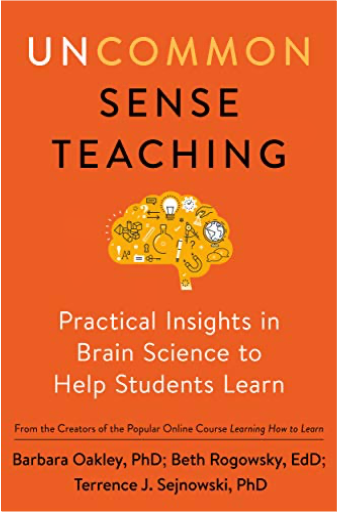
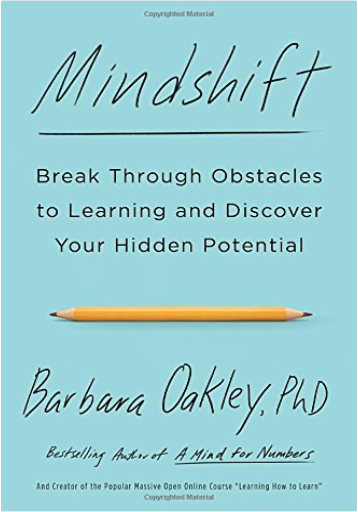
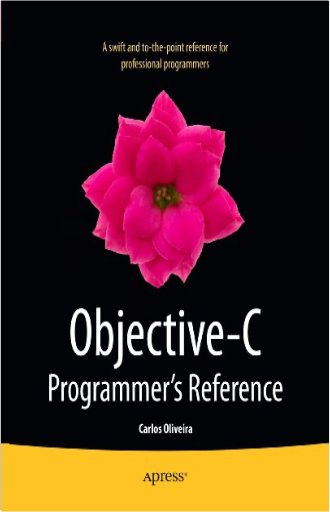
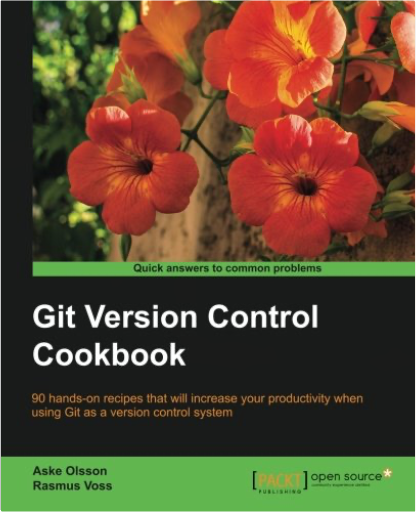
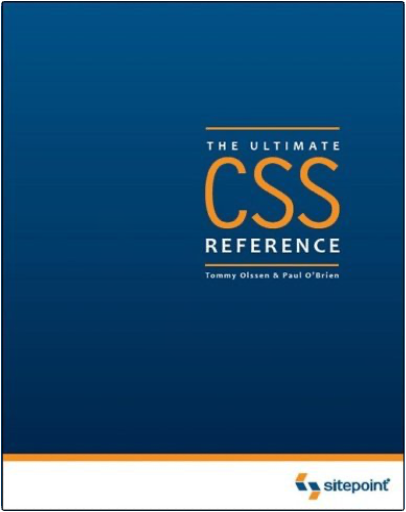
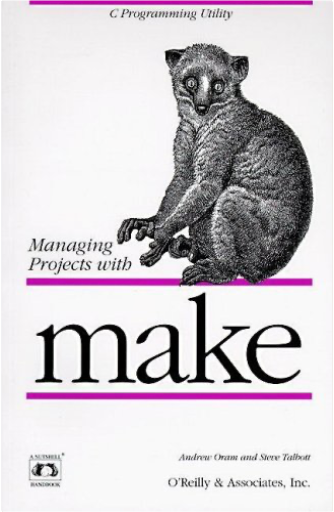
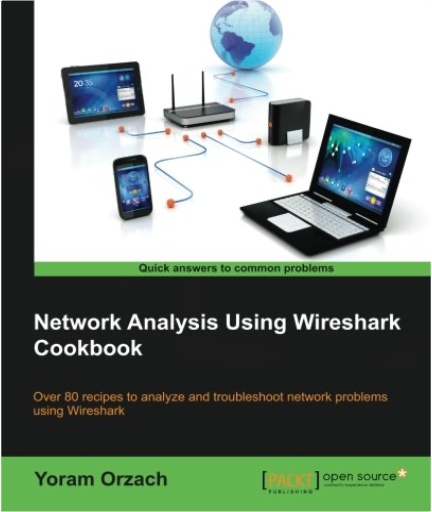
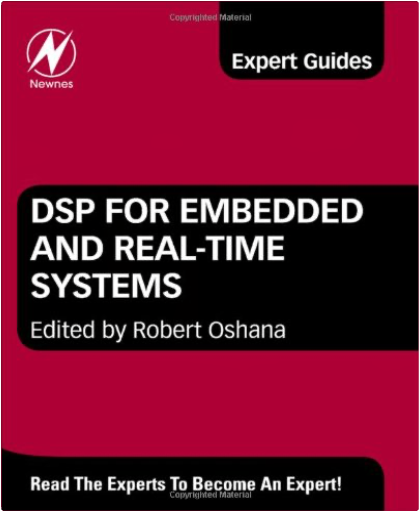
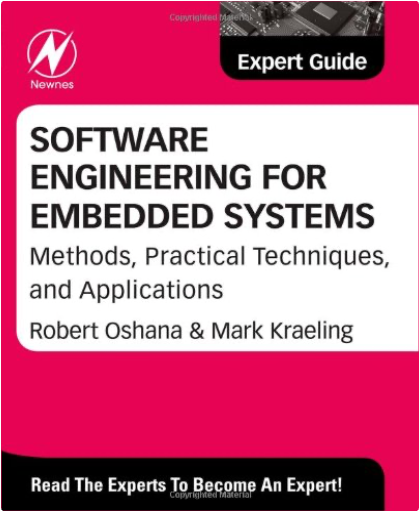
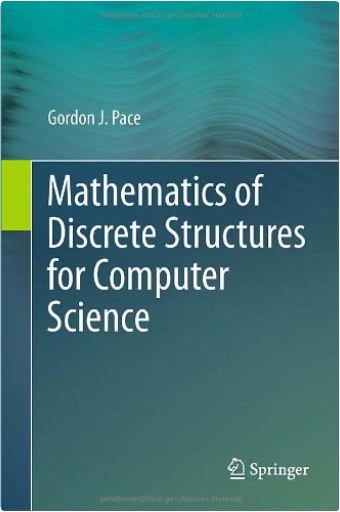
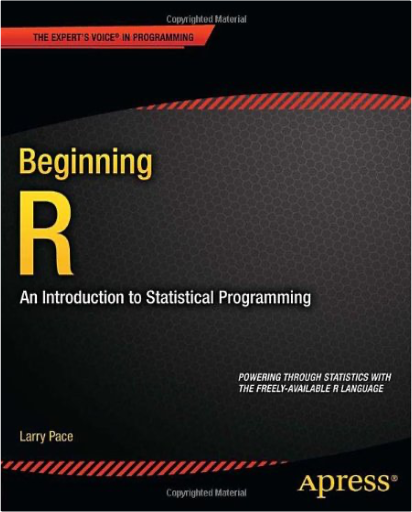
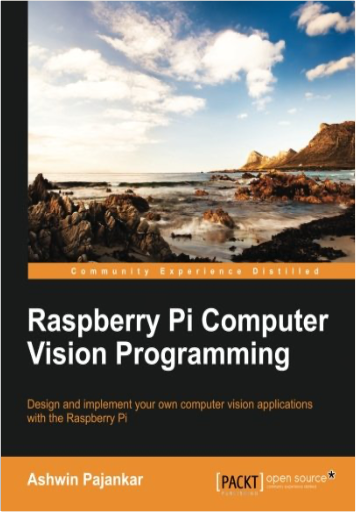
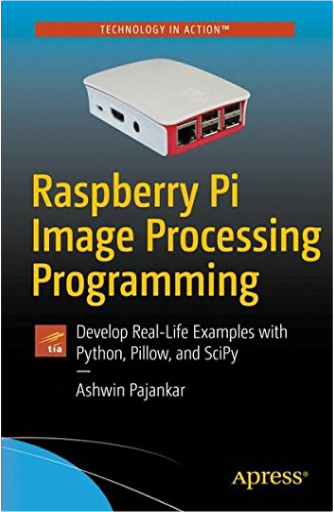
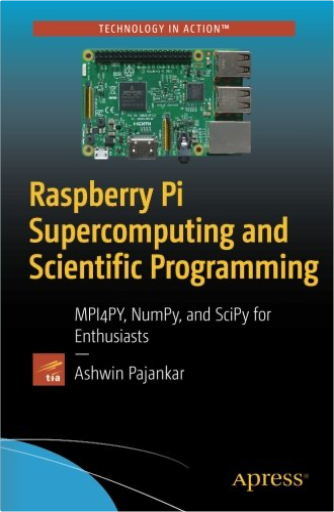


 Made with Delicious Library
Made with Delicious Library